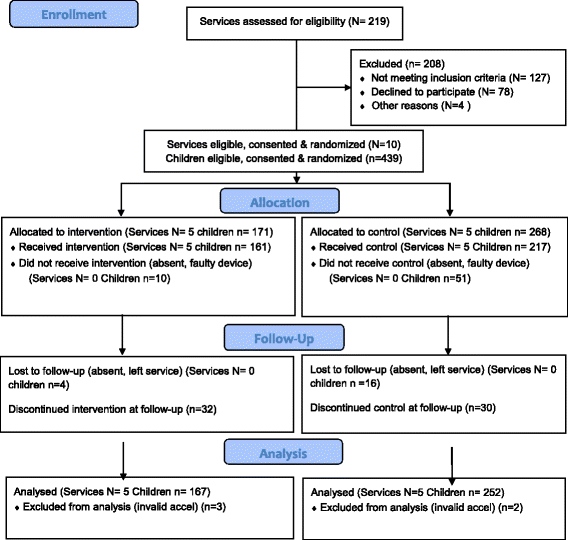Impact of scheduling multiple outdoor free-play periods in childcare on child moderate-to-vigorous physical activity: a cluster randomised trial
- PMID: 29615061
- PMCID: PMC5883422
- DOI: 10.1186/s12966-018-0665-5
Impact of scheduling multiple outdoor free-play periods in childcare on child moderate-to-vigorous physical activity: a cluster randomised trial
Abstract
Background: Increasing the frequency of periods of outdoor free-play in childcare may represent an opportunity to increase child physical activity. This study aimed to assess the efficacy of scheduling multiple periods of outdoor free-play in increasing the time children spend in moderate-to-vigorous physical activity (MVPA) while attending childcare.
Methods: The study employed a cluster randomised controlled trial design involving children aged 3 to 6 years, attending ten childcare services in the Hunter New England region of New South Wales, Australia. Five services were randomised to receive the intervention and five to a control condition. The intervention involved services scheduling three separate periods of outdoor free-play from 9 am to 3 pm per day, each at least 15 min in duration, with the total equivalent to their usual daily duration of outdoor play period. Control services implemented the usual single continuous period of outdoor free-play over this time. The primary outcome, children's moderate-to-vigorous physical activity (MVPA) while in care per day, was measured over 5 days via accelerometers at baseline and at 3 months post baseline. Secondary outcomes included percentage of time spent in MVPA while in care per day, total physical activity while in care per day and documented child injury, a hypothesised potential unintended adverse event. Childcare services and data collectors were not blind to the experimental group allocation.
Results: Parents of 439 (71.6%) children attending participating childcare services consented for their child to participate in the trial. Of these, 316 (72.0%) children provided valid accelerometer data at both time points. Relative to children in control services, mean daily minutes of MVPA in care was significantly greater at follow-up among children attending intervention services (adjusted difference between groups 5.21 min, 95% CI 0.59-9.83 p = 0.03). Percentage of time spent in MVPA in care per day was also greater at follow-up among children in intervention services relative to control services (adjusted difference between groups 1.57, 95% CI 0.64-2.49 p < 0.001). Total physical activity while in care per day, assessed via counts per minute approached but did not reach significance (adjusted difference between groups 14.25, 95% CI 2.26-30.76 p = 0.09). There were no differences between groups in child injury nor subgroup interactions for the primary trial outcome by child age, sex, or baseline MVPA levels.
Conclusion: Scheduling multiple periods of outdoor free-play significantly increased the time children spent in MVPA while in attendance at childcare. This simple ecological intervention could be considered for broader dissemination as a strategy to increase child physical activity at a population level.
Trial registration: This trial was prospectively registered with the Australian New Zealand Clinical Trials Registry (ANZCTR) ( ACTRN1261000347460 ). Prospectively registered 17th March 2016.
Keywords: Child day care services; Childcare; Intervention; Outdoor; Physical activity; Preschool; Randomised controlled trial; Scheduling; Young children.
Conflict of interest statement
Ethics approval and consent to participate
Ethical approval to conduct the study has been obtained from the Hunter New England Human Research Ethics Committee (reference number 15/11/ 18/4.03) and the University of Newcastle Human Research Ethics Committee (reference number H-2016-0088). Active parental consent was required for child participation in the study.
Competing interests
The authors have no competing interests to declare.
Publisher’s Note
Springer Nature remains neutral with regard to jurisdictional claims in published maps and institutional affiliations.
Figures
References
-
- Tandon PS, Tovar A, Jayasuriya AT, Welker E, Schober DJ, Copeland K, Dev DA, Murriel AL, Amso D, Ward DS. The relationship between physical activity and diet and young children’s cognitive development: a systematic review. Prev Med Rep. 2016;3:379–390. doi: 10.1016/j.pmedr.2016.04.003. - DOI - PMC - PubMed
-
- Logan SW, Kipling Webster E, Getchell N, Pfeiffer KA, Robinson LE. Relationship between fundamental motor skill competence and physical activity during childhood and adolescence: a systematic review. Kinesiol Rev. 2015;4(4):416–426. doi: 10.1123/kr.2013-0012. - DOI
-
- Malina RM. Tracking of physical activity and physical fitness across the lifespan. Res Q Exerc Sport. 1996;67(3 Suppl):S48–S57. - PubMed
Publication types
MeSH terms
Associated data
Grants and funding
LinkOut - more resources
Full Text Sources
Other Literature Sources
Medical


